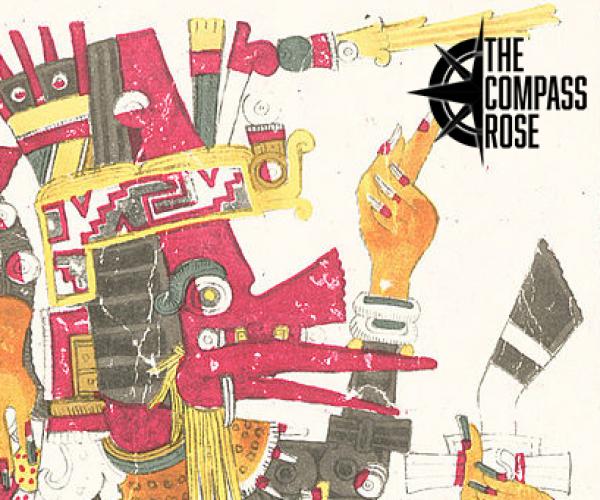
The Codex Borgia - Codex Yoalli Ehēcatl
The purpose of The Compass Rose is to raise awareness of Special Collections' resources and to foster the use of these resources. The blog series also reports significant new programs, initiatives, and acquisitions of Special Collections.
Hispanic Heritage Month gives us time to reflect on the diverse history of Hispanic and Latinx communities. Religious practices, music, food, art, and languages throughout Latin America and the Caribbean reflect the Indigenous, African, European, and Asian backgrounds of the people in this region. Spanish colonization and subsequent issues involving colorism and racism have greatly affected how people view and understand Hispanic and Latinx history and culture. New and more inclusive interpretations of historical events and narratives help us get a more accurate image of the communities and people who created Hispanic, Latin, and Caribbean America.
This blog will provide insight into the Aztec religion by briefly analyzing the Codex Borgia - Codex Yoalli Ehēcatl. Surviving works such as codices help us gain greater insight into Indigenous faiths, and help us understand some of the religious and spiritual concepts that continue to this day in different communities.
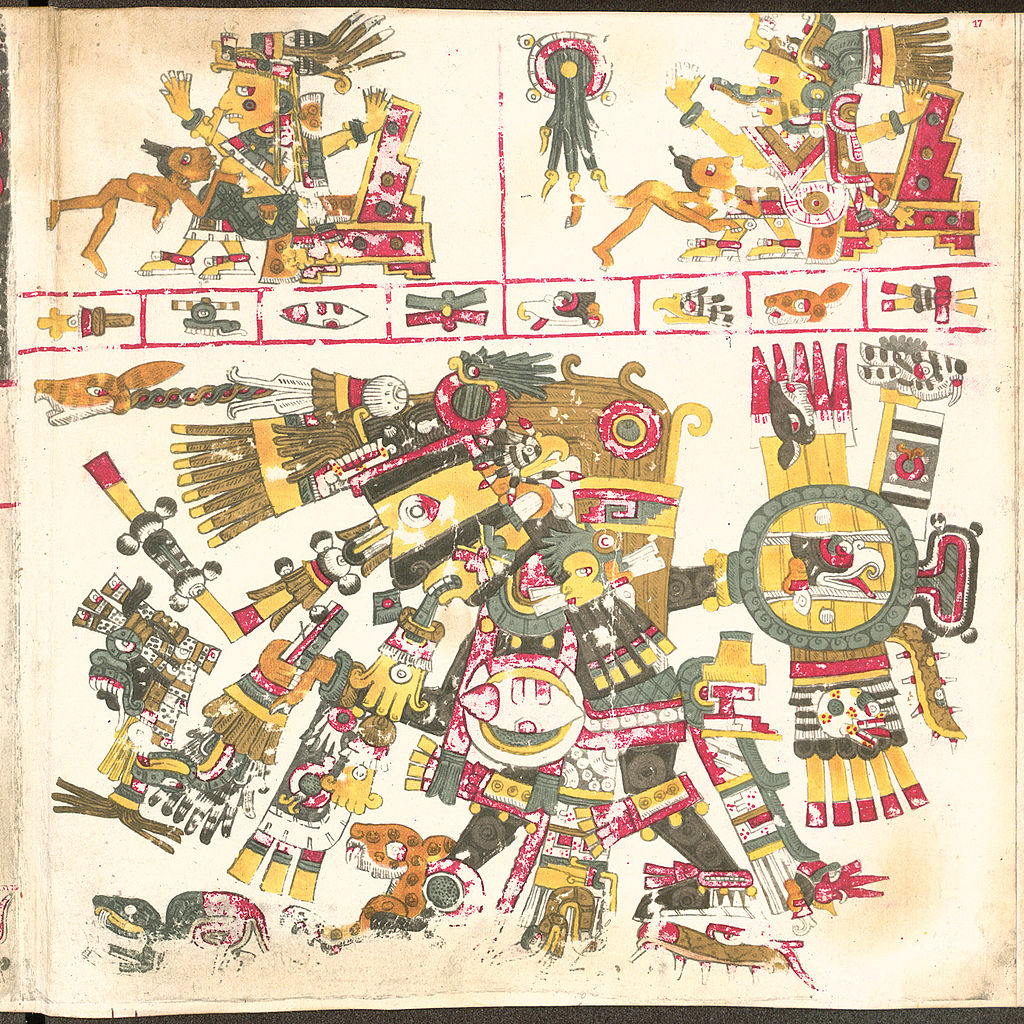
A large depiction of Tezcatlipoca, with day signs associated with different parts of his body.
The Codex Borgia - Codex Yoalli Ehēcatl
A codex is an ancestor of the modern book. Indigenous communities of the Americas created codices on long sheets of plant or bark-based paper. This paper would be folded accordion-style, with both sides used for drawing glyphs and images.
The Codex Borgia, also known as the Codex Yoalli Ehēcatl, is one of the few codices to survive a Spanish auto-de-fé destruction of Indigenous religious texts. It was created in Central Mexico by a Nahuatl speaking community and comprises of 28 sections of religious and cultural information. Much of the text revolves around the Central Mexican divinatory calendar, the Tonalpohualli, divinatory content, and the associations between deities and time periods.
We do not know when this codex arrived in Europe, but it is estimated to have been taken out of Mexico during the Spanish colonial period. It was first recorded in Europe as being in the collection of Cardinal Stefano Borgia (1731-1804) and carried his surname as its title when Borgia’s collection was moved to the Apostolic Library of the Vatican in 1902. The Codex Borgia held at the UTA Special Collections is a facsimile of the original codex.
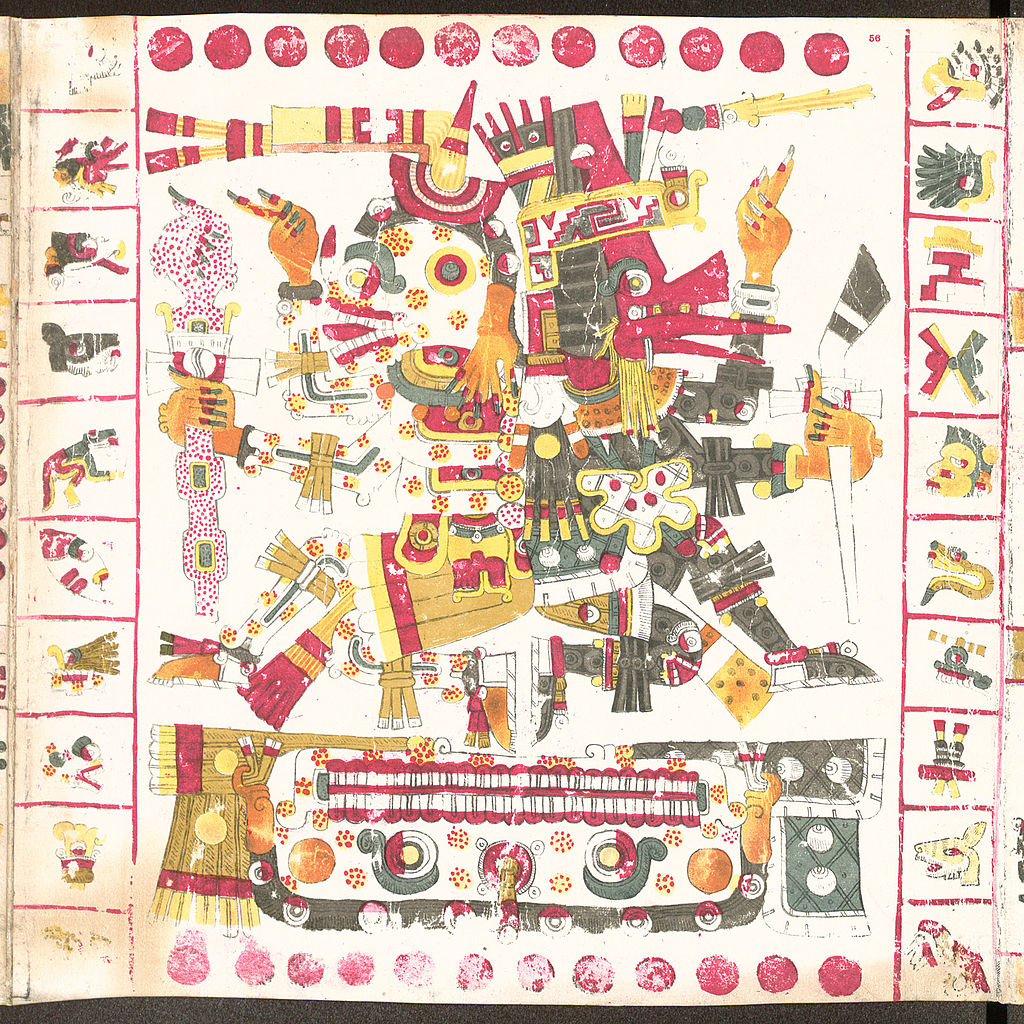
Aztec gods Mictlantecuhtli and Quetzalcoatl standing back to back
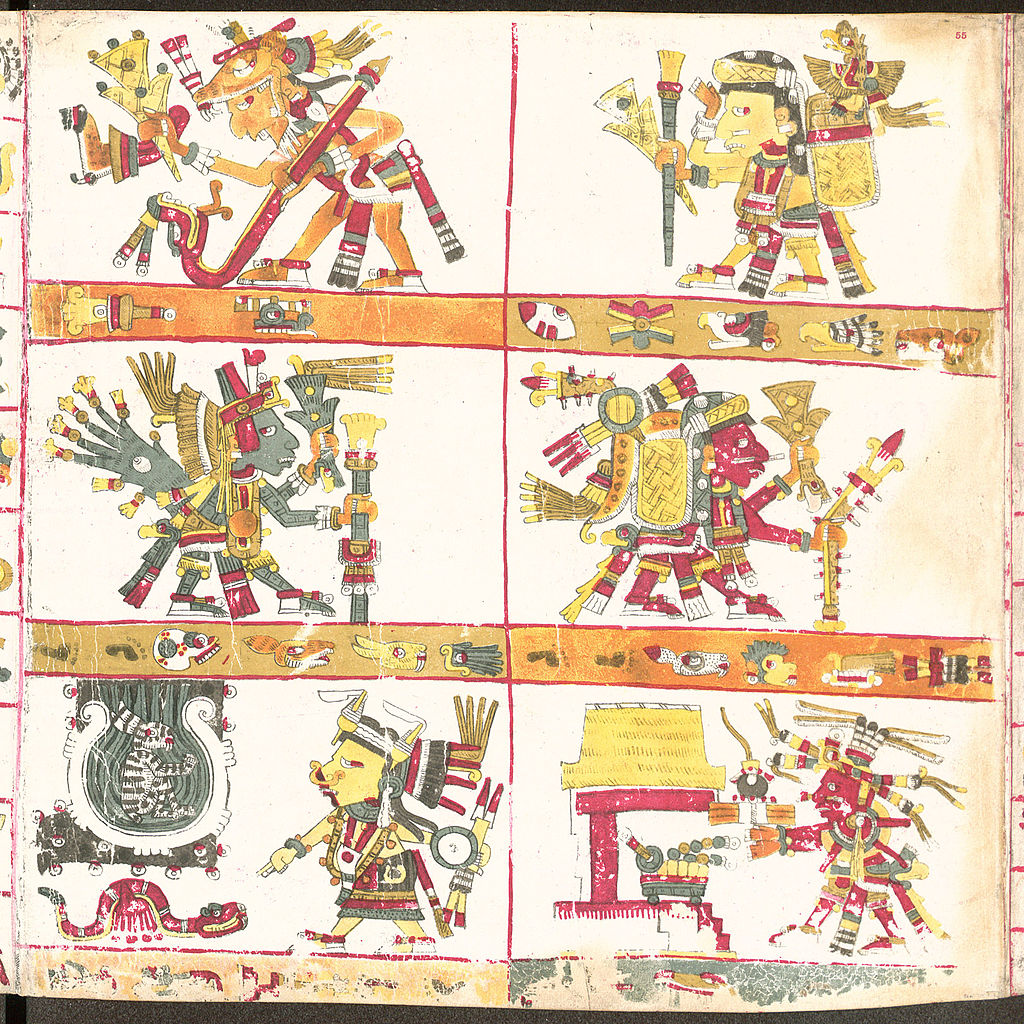
Six Aztec deities surrounded by their day signs and prophecies associated with their dates
Left Page
Along the sides of this page is the Central Mexican divinatory calendar, the Tonalpohualli. At the center of the page are Mictlāntēcutli and Quetzalcoatl standing back-to-back.
Facing left is Mictlāntēcutli, one of the principal gods of the Aztecs. He is the Aztec god of death, the South, owls, spiders, and dogs. He and his wife Mictēcacihuātl are King and Queen of Mictlān, the underworld of Aztec mythology.
Quetzalcóatl, the Feathered Serpent god, is the Aztec god of the wind, priesthood, learning and wisdom, agriculture, and science. He is one of the principal gods of the Aztecs and was called by several titles including lord of the day and the winds and ruler of the West. He is a creator deity who held an essential role in the creation of humanity. He was one of the Feathered Serpent deities found in many Mesoamerican religions. The Yucatec Maya called their Feathered Serpent deity Kukulcan, and the K’iche’ Maya called him Q’uq’umatz and Tohil. Presented on this page is Quetzalcóatl in his human form.
Right Page
This page depicts six Aztec deities and their ruling day signs in the Aztec calendar along with their associated prophecies or foretelling.
The top left deity is Huēhuecoyōtl, patron deity of uninhibited sexuality and god of music, dance, song, and mischief. The top right deity is Zacatzontli, protector of merchants and god of the day road. The center left deity is Yacatecuhtli, god of commerce and travelers. The center right deity is Tlacotzontli, god of roads. The bottom left deity is Tlazōlteōtl, patroness of adulterers and goddess of purification, steam baths, lust, and filth. The bottom right deity is Tōnatiuh, a sun deity whose form travelled across the sky every day.
This page depicts two types of spirits: the Ahuiyateteo or Macuiltonaleque, gods of excess and pleasure and the consequences of engaging in such behavior, and Cihuateteo, the spirits of women who died while giving birth.
In the Aztec religion, childbirth was seen as equally dangerous and honorable as fighting in combat. Women were viewed as warriors fighting to bring life into the world, with the delivery of a living child being viewed the same as delivering a victorious battle or captive enemy to the Aztec nations. If a woman died in childbirth, her soul went into the heavens along with the souls of warriors who died in battle, whereas other souls went into the underworld of Mictlan. Every day, the spirits of these two types of warriors would help carry the sun through the heavens. Her remains would be closely guarded until burial: the magic surrounding woman who died and became a Cihuateteo was seen as so powerful that parts of her remains turned into relics that had the power to help warriors in battle. Cihuateteo became malevolent on certain dates, which were noted in Aztec calendars. On those dates, Cihuateteo could steal children or seduce men. In response, offerings were left on roads to appease these spirits.
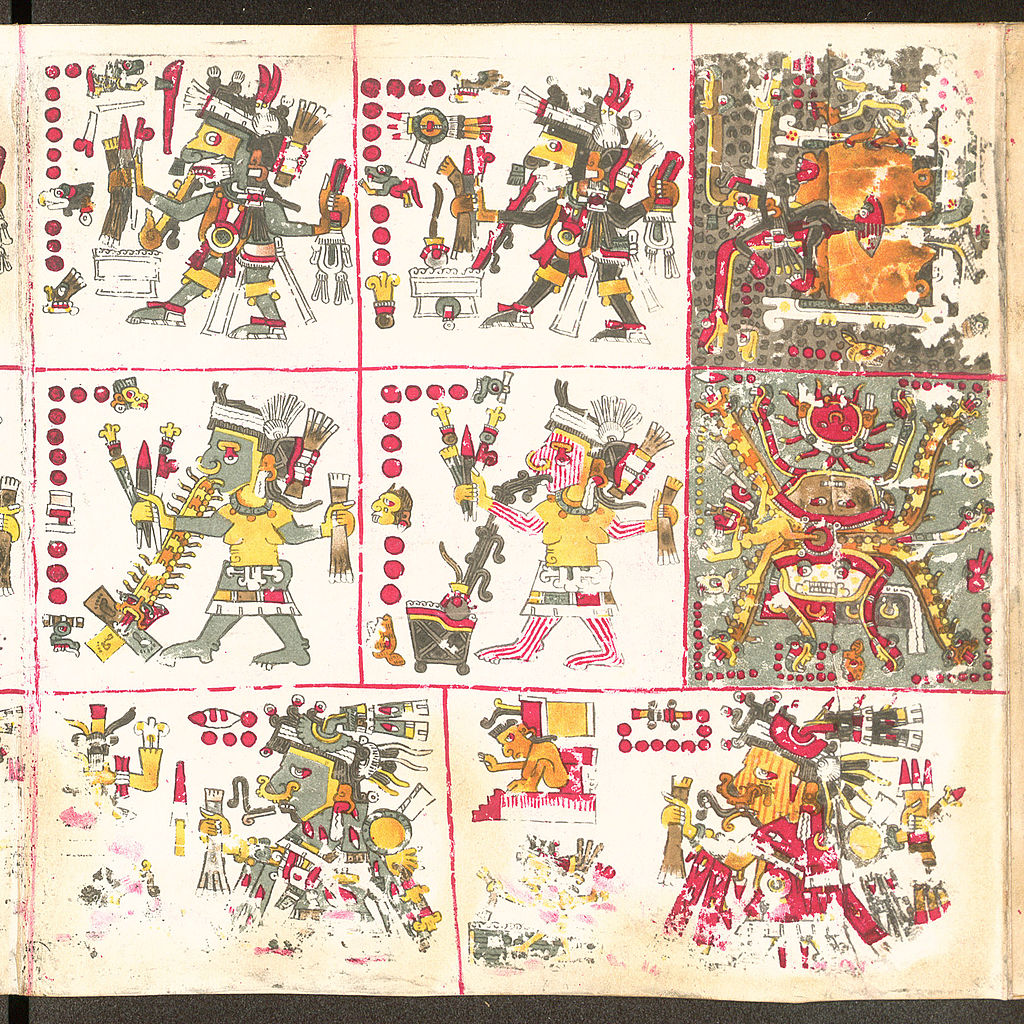
Cihuateteo, the divinized spirits of the women that died in child-birth, and the Macuiltonaleque, minor spirits of excess, pleasure and violence.
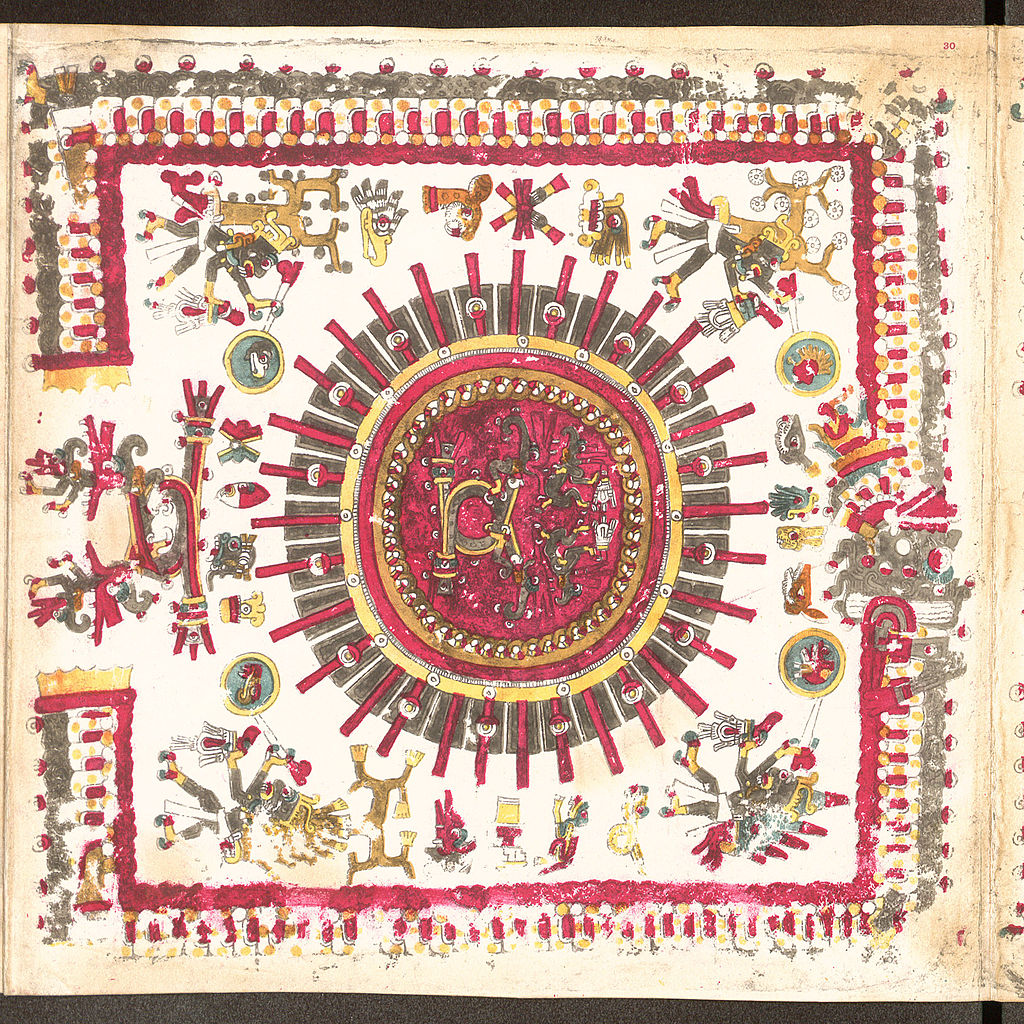
Image depicting the practice of the cult of the rain gods.
One section of the Codex has been subject to much debate over the years. Pages 29 to 46 of the Codex were long considered to be depictions of astronomy or a zodiac. Later interpretations have concluded that this section is not referring to astrological events, but rather depicts religious events and practices. On this page is a depiction of a worship ritual for the rain gods. To date, other interpretations of this section are debated, and time will tell if researchers and historians can make a final determination about what these images truly mean.
This Hispanic Heritage Month, and indeed every month of the year, it is important to learn about the history of the diverse communities that have created and shaped today's cultures and ideas. Historical works and narratives help us learn about who we come from, and how the ideas and beliefs of our ancestors impact us to this day.

Add new comment